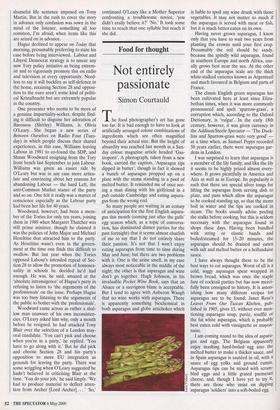Food for thought
Not entirely passionate
Simon Courtauld
So many people are waiting in an ecstasy of anticipation for the first English aspara- gus this month (coming just after the gulls' egg season which, as a topic of conversa- tion, has dominated dinner parties for the past fortnight) that it seems almost churlish of me to say that I do not entirely share their passion. It's not that I won't enjoy eating asparagus from time to time during May and June; but there are two problems with it. One is the urine smell, in my case always most noticeable in the middle of the night; the other is that asparagus and wine don't go together. Hugh Johnson, in his invaluable Pocket Wine Book, says that an Alsace or a sauvignon blanc is acceptable. But I tend to agree with Auberon Waugh that no wine works with asparagus. There is apparently something biochemical in both asparagus and globe artichokes which is liable to spoil any wine drunk with those vegetables. It may not matter so much if the asparagus is served with meat or fish, but it is much better eaten on its own.
Having never grown asparagus, I know only that you have to wait two years from planting the crowns until your first crop. Presumably the soil should be sandy, because the spindly wild asparagus, found in southern Europe and north Africa, usu- ally grows best near the sea. At the other end of the asparagus scale are the thick white-stalked varieties known as Argenteuil and much favoured in Belgium and parts of France.
The classic English green asparagus has been cultivated here at least since Eliza- bethan times, when it was more commonly pronounced and spelt 'sparrow-grass', a corruption which, according to the Oxford Dictionary, is 'vulgar'. In the early 18th century, however, it was given currency in the Addison/Steele Spectator — The Duck- lins and Sparrow-grass were very good' — at a time when, as Samuel Pepys recorded 50 years earlier, there were asparagus gar- dens in London.
I was surprised to learn that asparagus is a member of the lily family; and like the lily it seems to be highly prized almost every- where. It grows plentifully in America and Asia as well as in Europe. Its popularity is such that there are special silver tongs for lifting the asparagus from serving dish to plate, and pans which allow the asparagus to be cooked standing up, so that the stems boil in water and the tips are cooked in steam. The books usually advise peeling the stalks before cooking, but this is seldom necessary with the asparagus found in shops these days. Having been bundled with string or elastic bands and boiled/steamed for 15-20 minutes, the asparagus should be drained and eaten with salt and melted butter or a hollandaise sauce.
I have always thought these to be the best ways to eat asparagus. Worst of all is a cold, soggy asparagus spear wrapped in brown bread, which was once the staple fare of cocktail parties but has now merci- fully been consigned to history. It is aston- ishing how many different recipes for asparagus are to be found; Janet Ross's Leaves From Our Tuscan Kitchen, pub- lished in 1905, gives 15, without ever men- tioning asparagus soup, purée, soufflé or the fat white asparagus, which is probably best eaten cold with vinaigrette or mayon- naise, I am coming round to the idea of aspara- gus and eggs. The Belgians apparently enjoy mashing hard-boiled egg into the melted butter to make a thicker sauce, and in Spain asparagus is sautéed in oil, with a sauce of egg yolks and ground cumin. Asparagus tips can be mixed with scram- bled eggs and a little grated parmesan cheese, and, though I have yet to try it, there are those who insist on dipping asparagus 'soldiers' into a soft-boiled egg.


































































 Previous page
Previous page